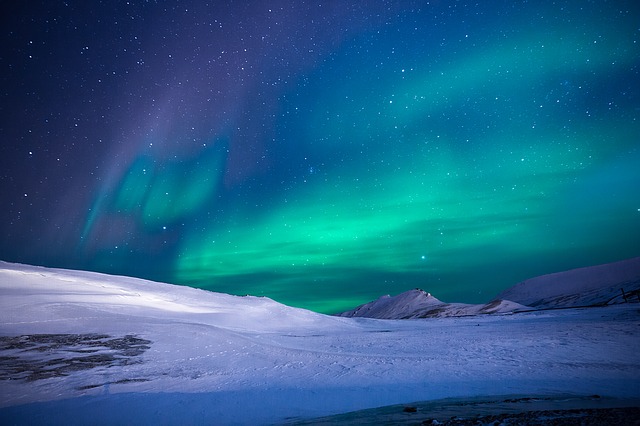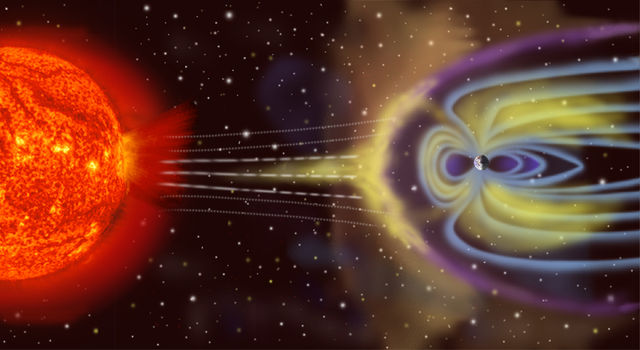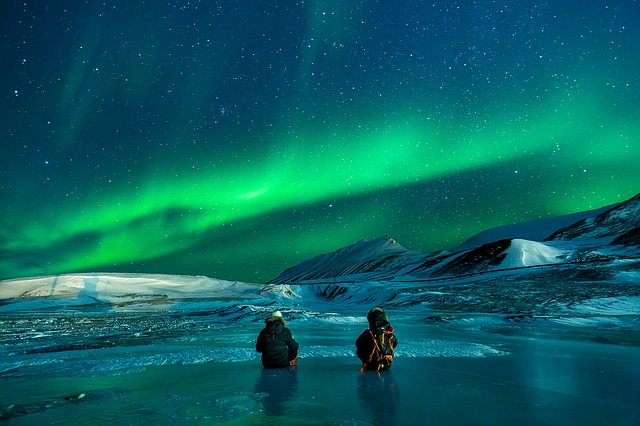
Auroras (Polar Lights; or aurorae, sing.: aurora) are natural different colored light displays, which are usually observed in the night sky, particularly in the polar zone. Some scientists therefore call them “polar auroras” (or “aurorae polaris”). In northern latitudes, it is known as the aurora borealis, named after the Roman goddess of the dawn, Aurora, and the Greek name for north wind, Boreas. It often appears as a greenish glow (or sometimes a faint red), as if the sun were rising from an unusual direction. The aurora borealis is also called the northern polar lights, as it is only visible in the North sky from the Northern Hemisphere. The aurora borealis most often occurs from September to October and from March to April.Its southern counterpart, the aurora australis/southern polar lights, has similar properties. Australis is the Latin word for “of the South”.
Auroral mechanism
Auroras are produced by the collision of charged particles, mostly electrons but also protons and heavier particles, from the magnetosphere, with atoms and molecules of the Earth’s upper atmosphere (at altitudes above 80 km). The particles have energies from 1-100 keV. Most originate from the sun and arrive at the vicinity of earth in the relatively low-energy solar wind. When the trapped magnetic field of the solar wind is favourably oriented (principally southwards) it reconnects with that of the earth and solar particles then enter the magnetosphere and are swept to the magnetotail. Further magnetic reconnection accelerates the particles towards earth.
The collisions in the atmosphere electronically excite atoms and molecules in the upper atmosphere. The excitation energy can be lost by light emission or collisions. Most aurorae are green and red emission from atomic oxygen. Molecular nitrogen and nitrogen ions produce some low level red and very high blue/violet aurorae.

Auroral forms and magnetism
Typically the aurora appears either as a diffuse glow or as “curtains” that approximately extend in the east-west direction. At some times, they form “quiet arcs”; at others (“active aurora”), they evolve and change constantly. Each curtain consists of many parallel rays, each lined up with the local direction of the magnetic field lines, suggesting that aurora is shaped by the earth’s magnetic field. Indeed, satellites show electrons to be guided by magnetic field lines, spiraling around them while moving earthwards.
The curtains often show folds called “striations”, which are curtain-like. When the field line guiding a bright auroral patch leads to a point directly above the observer, the aurora may appear as a “corona” of diverging rays, an effect of perspective.
Although it was first mentioned by Ancient Greek explorer/geographer Pytheas, Hiorter and Celsius first described in 1741 evidence for magnetic control, namely, large magnetic fluctuations occurred whenever the aurora was observed overhead. This indicates (it was later realized) that large electric currents were associated with the aurora, flowing in the region where auroral light originated. Kristian Birkeland (1908) deduced that the currents flowed in the east-west directions along the auroral arc, and such currents, flowing from the dayside towards (approximately) midnight were later named “auroral electrojets” (see also Birkeland currents).
Still more evidence for a magnetic connection are the statistics of auroral observations. Elias Loomis (1860) and later in more detail Hermann Fritz (1881) established that the aurora appeared mainly in the “auroral zone”, a ring-shaped region with a radius of approximately 2500 km around the magnetic pole of the earth, not its geographic one. It was hardly ever seen near that pole itself. The instantaneous distribution of auroras (“auroral oval”, Yasha/Jakob Feldstein 1963) is slightly different, centered about 3-5 degrees nightward of the magnetic pole, so that auroral arcs reach furthest towards the equator around midnight. The aurora can be seen best at this time.

The solar wind and magnetosphere
The earth is constantly immersed in the solar wind, a rarefied flow of hot plasma (gas of free electrons and positive ions) emitted by the sun in all directions, a result of the million-degree heat of the sun’s outermost layer, the solar corona. The solar wind usually reaches Earth with a velocity around 400 km/s, density around 5 ions/cc and magnetic field intensity around 2–5 nT (nanoteslas; the earth’s surface field is typically 30,000–50,000 nT). These are typical values. During magnetic storms, in particular, flows can be several times faster; the interplanetary magnetic field (IMF) may also be much stronger.
The IMF originates on the sun, related to the field of sunspots, and its field lines (lines of force) are dragged out by the solar wind. That alone would tend to line them up in the sun-earth direction, but the rotation of the sun skews them (at Earth) by about 45 degrees, so that field lines passing Earth may actually start near the western edge (“limb”) of the visible sun.
The earth’s magnetosphere is the space region dominated by its magnetic field. It forms an obstacle in the path of the solar wind, causing it to be diverted around it, at a distance of about 70,000 km (before it reaches that boundary, typically 12,000–15,000 km upstream, a bow shock forms). The width of the magnetospheric obstacle, abreast of Earth, is typically 190,000 km, and on the night side a long “magnetotail” of stretched field lines extends to great distances.
When the solar wind is perturbed, it easily transfers energy and material into the magnetosphere. The electrons and ions in the magnetosphere that are thus energized move along the magnetic field lines to the polar regions of the atmosphere.
The origin of the aurora
The ultimate energy source of the aurora is the solar wind flowing past the Earth. Both the magnetosphere and the solar wind consist of plasma (ionized gas), which conducts electricity. It is well known (since Michael Faraday’s [1791 – 1867] work around 1830) that when an electrical conductor is placed within a magnetic field while relative motion occurs in a direction that the conductor cuts across (or is cut by), rather than along, the lines of the magnetic field, an electrical current is said to be induced into that conductor and electrons will flow within it. The amount of current flow is dependent upon a) the rate of relative motion and b) the strength of the magnetic field, c) the number of conductors ganged together and d) the distance between the conductor and the magnetic field, while the direction of flow is dependent upon the direction of relative motion. Dynamos make use of this basic process (“the dynamo effect”), any and all conductors, solid or otherwise are so affected including plasmas or other fluids.
In particular the solar wind and the magnetosphere are two electrically conducting fluids with such relative motion and should be able (in principle) to generate electric currents by “dynamo action”, in the process also extracting energy from the flow of the solar wind. The process is hampered by the fact that plasmas conduct easily along magnetic field lines, but not so easily perpendicular to them. It is therefore important that a temporary magnetic interconnection be established between the field lines of the solar wind and those of the magnetosphere, by a process known as magnetic reconnection. It happens most easily with a southward slant of interplanetary field lines, because then field lines north of Earth approximately match the direction of field lines near the north magnetic pole (namely, into the earth), and similarly near the southern pole. Indeed, active auroras (and related “substorms”) are much more likely at such times.
Electric currents originating in such fashion apparently give auroral electrons their energy. The magnetospheric plasma has an abundance of electrons: some are magnetically trapped, some reside in the magnetotail, and some exist in the upward extension of the ionosphere, which may extend (with diminishing density) some 25,000 km around the earth.

Bright auroras are generally associated with Birkeland currents which flow down into the ionosphere on one side of the pole and out on the other. In between, some of the current connects directly through the ionospheric E layer (125 km); the rest (“region 2”) detours, leaving again through field lines closer to the equator and closing through the “partial ring current” carried by magnetically trapped plasma. The ionosphere is an ohmic conductor, so such currents require a driving voltage, which some dynamo mechanism can supply. Electric field probes in orbit above the polar cap suggest voltages of the order of 40,000 volts, rising up to more than 200,000 volts during intense magnetic storms.
Ionospheric resistance has a complex nature, and leads to a secondary Hall current flow. By a strange twist of physics, the magnetic disturbance on the ground due to the main current almost cancels out, so most of the observed effect of auroras is due to a secondary current, the auroral electrojet. An auroral electrojet index (measured in nanotesla) is regularly derived from ground data and serves as a general measure of auroral activity.
However, ohmic resistance is not the only obstacle to current flow in this circuit. The convergence of magnetic field lines near Earth creates a “mirror effect” which turns back most of the down-flowing electrons (where currents flow upwards), inhibiting current-carrying capacity. To overcome this, part of the available voltage appears along the field line (“parallel to the field”), helping electrons overcome that obstacle by widening the bundle of trajectories reaching Earth; a similar “parallel voltage” is used in “tandem mirror” plasma containment devices. A feature of such voltage is that it is concentrated near Earth (potential proportional to field intensity; Persson, 1963), and indeed, as deduced by Evans (1974) and confirmed by satellites, most auroral acceleration occurs below 10,000 km. Another indicator of parallel electric fields along field lines are beams of upwards flowing O+ ions observed on auroral field lines.
While this mechanism is probably the main source of the familiar auroral arcs, formations conspicuous from the ground, more energy might go to other, less prominent types of aurora, e.g. the diffuse aurora and the low-energy electrons precipitated in magnetic storms.
Some O+ ions (“conics”) also seem accelerated in different ways by plasma processes associated with the aurora. These ions are accelerated by plasma waves, in directions mainly perpendicular to the field lines. They therefore start at their own “mirror points” and can travel only upwards. As they do so, the “mirror effect” transforms their directions of motion, from perpendicular to the line to lying on a cone around it, which gradually narrows down.
In addition, the aurora and associated currents produce a strong radio emission around 150 kHz known as auroral kilometric radiation (AKR, discovered in 1972). Ionospheric absorption makes AKR observable from space only.
These “parallel voltages” accelerate electrons to auroral energies and seem to be a major source of aurora. Other mechanisms have also been proposed, in particular, Alfvén waves, wave modes involving the magnetic field first noted by Hannes Alfvén (1942), which have been observed in the lab and in space. The question is however whether this might just be a different way of looking at the above process, because this approach does not point out a different energy source, and many plasma bulk phenomena can also be described in terms of Alfvén waves.
Other processes are also involved in the aurora, and much remains to be learned. Auroral electrons created by large geomagnetic storms often seem to have energies below 1 keV, and are stopped higher up, near 200 km. Such low energies excite mainly the red line of oxygen, so that often such auroras are red. On the other hand, positive ions also reach the ionosphere at such time, with energies of 20-30 keV, suggesting they might be an “overflow” along magnetic field lines of the copious “ring current” ions accelerated at such times, by processes different from the ones described above.
Shortened article and images from wikipedia.org. Published under the terms of the GNU Free Documentation License, Version 1.2.
